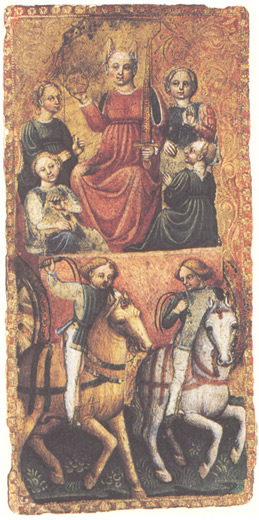Iacopo Sagramoro (- ca. 1459)
a man for the cheap things, for instance Tarot Cards
| Jacopo di Batheolomeo Sagramoro seems to have had also the name of Iacopo da Bononia (=Bologna)
or Iacopo da Soncino, although both are different locations. His name is connected to the first entry about playing cards in Ferrara (1422), with this Sagramoro is in concurrence to Michelino da Besozzo as first mentioned playing card painter in Italy. Also to some playing cards in the 30ies, to the great riddle, the present to Bianca Maria in January 1441, to the first use of the name "Trionfi" (1442), in context with Marchione Burdochi and beside the Bembo-school in Cremona Sagramoro is the "great Trionfi painter" in the years 1450 - 1456, when Trionfi started to be a well known and much used card deck (he is active till 1456 and appears in the documents B 01 04 07 09 10 15 18 ). But another fact: Sagramoro is simply the most mentioned artist in more than 30 years of all the Este account books. He is the grey humble man in the background, not really noted, as he always was there. Always good for the small not so well paid jobs (Ortalli mentions, that he was very often employed by the d'Este court, working "on friezes, the decorations of ceilings, walls, tracery as well as court carriages, pennons, crests, flags, nuptial trunks, harnesses, pattern for fabrics and embroidery"). Art historians forget about him. Mostly he painted heraldic designs, as they were needed everywhere to show: this is property of the d'Este. And this is property of the d'Este. And this ... and often - this was Sagramoro. A boring job. Probably Sagramoro developed tricks to become quick with it. And because of that: He was cheap. When it came to paint playing cards, many, many playing cards, again a boring matter, Sagramoro knew about the tricks to make them without too much effort. So he was cheap and useful in this job. And cause of this reason: He got the job. So it happened: Sagramoro became Trionfi-painter. He was already old, when this occupation developed and his style probably was a little bit old-fashioned. The interpretations of the entries about playing cards in the account books are difficult, Ortalli presents the opinion, that it occasionally appears, as if Sagramoro were only and mainly occupied with "repairing cards" or "with painting the back of cards" (possibly according to his specialisation on heraldic devices, which were probably the decorations on the backs of the cards dedicated for the courtly use). The playing card at the right possibly had been painted by Sagramoro. The motive is unclear: Fortuna or Chariot? Fortuna and Chariot might have been part of the Imperatori deck, so this card might be the final fragment of such a deck (in that case the Ferrarese specialist for Imperatori-cards, Piero Andrea de Bonsignore, might have been the artist). Sagramoro, a minor, more or less unknown artistThe only biographical information available about Sagramoro comes from the archives published by Franceschini. Sagramoro had a daughter Dorothea, who in 1459 was given title to lands which had been given to her father in 1444 - probably 1459 is the year of Sagromoros death; he made his last will two times, in 1456 and 1457 and was replaced as main courtly Trionfi painter by Gherardo da Viczenza. Gherardo was also already old, when getting the place of Sagramoro. Probably both were used to the old-fashioned style, Gherardo could imitate it. Another source about Sagramoro is in Giuseppe Campori, 1885, "I pittori degli Estensi nel secolo XV" pp. 538-539, momentary not available.Sagramoro, the great Tarot-painterSagramoro is mentioned in the first entry about playing cards in Ferrara in 1422. Sagramoro worked for Parasina and probably had greater insights of the tragedy in 1425. He cooperated with the printer, who appeared around 1436 with a printing-press for playing cards in Ferrara and experienced the progress of technology.Sagramoro painted 14 figures on cotton-paper for Bianca Maria for the amusement in the evening and was paid on 1st January 1441 - a great entry, who might carry the mystery about the invention of the 5x14-deck with 5th trumps-suit. In February 1442 Sagramoro is payed for the production of 4 Trionfi decks - it's the first note about a Trionfi-deck. Sagramoro became the great Trionfi or Tarot painter in Ferrara in the years 1450 - 56 in high age - probably 5x14-decks. After 1456 the artist Gherardo d'Andrea da Vicenza appears on the scene and it seems, that he took the job of Sagramoro as card-painter. His first production (1457) mentions a Trionfi-deck with 70 cards - probably still a 5x14-deck, perhaps the form, that Sagramoro developed in cooperation with some highborn teenagers and kids in the winter of a great decision in 1440/1441. And Sagramoro passed away, not knowing, that he became the hidden star of an internet page more than 500 years after his death. Well, the king of the 5x14-deck. (autorbis) |
 |